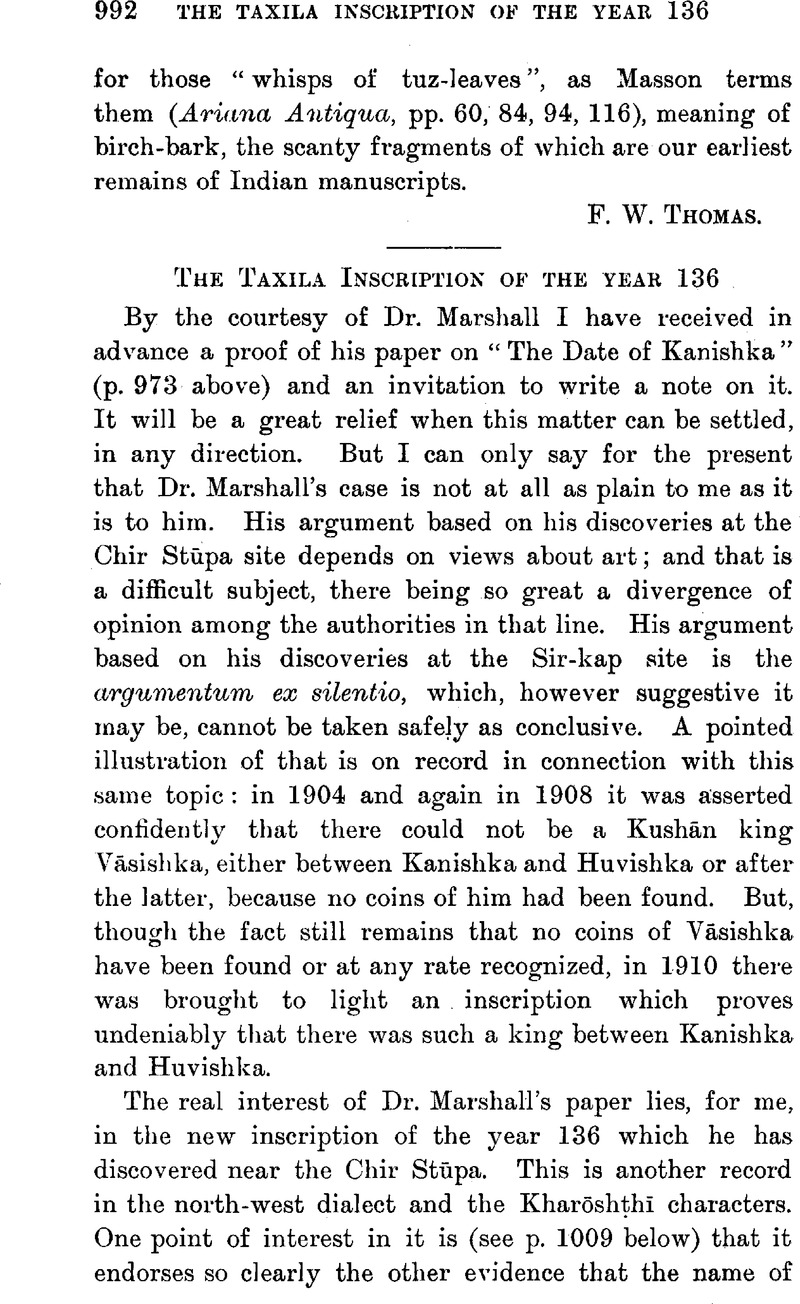No CrossRef data available.
Article contents
The Taxila Inscription of the Year 136
Published online by Cambridge University Press: 15 March 2011
Abstract

- Type
- Miscellaneous Communications
- Information
- Copyright
- Copyright © The Royal Asiatic Society 1914
References
page 992 note 1 DrMarshall, has quoted me (p. 977)Google Scholar as identifying the king of the Panjtār record with Wēmo-Kadphisēs. I said that he may be either Wēmo-Kadphisēs or Sōtēr Megas, “the Nameless King” (this Journal, 1913, p. 1011). Dr. Marshall seems to prefer to identify him with Kozoulo-Kadphisēs, who was reigning, according to him, in A.D. 65 and 79. It is only a question of how the date may be found to fit in best.
page 992 note 2 For the sake of simplicity I substitute 136 for the 100 20 10 4 1 1 of the original, and 15 for 10 4 1.
page 992 note 3 This idea, that there were two eras, beginning in and about B.C. 58, is not new: it is part and parcel of an almost unintelligible desire to try to interpret the early Indian records by means of any reckonings rather than the well-established Indian ones.
page 993 note 1 I do not share in this “most orthodox view”: see my remarks in this Journal, 1907, p. 1023; 1913, p. 1000; and p. 797 above. The grounds put forward for the identification of the two persons are two:— (1) That, if it is not made, then Moa-Mauēs has no inscriptions and Moga has no coins. A weaker reason than this could hardly be thought of. (2) That the word Moga is merely a dialectical variant of Moa. This is based on the point that a medial single g between two vowels was liable, like other single consonants so standing, to disappear. But not by any means has every such g disappeared. And in any circumstances, identity of name does not establish identity of person. Further, if Moa-Mauēs was also known as Moga, then how is it that the variant Moga has not been found on any of his coins, which are of at least sixteen different types? Also, it is to be borne in mind, as I have said on a previous occasion, that the form Moga presented in the record on the Taxila plate may quite possibly stand for Mogga (with the double gg), which could not possibly be even the same name with Moa.
page 993 note 2 His actual expression is the “reign” of Mauēs (p. 986). But, as he only assigns thirty-seven years (B.C. 95–58) for Mauēs before Azēs I, I infer that he must mean an “era” of Mauēs.
page 995 note 1 Here, again, for the sake of simplicity I substitute 78 for the 20 20 20 10 4 4 of the original, and 5 for 4 1.
page 995 note 2 This Journal, 1907, p. 1014.
page 995 note 3 Epi. Ind., vol. 4, p. 56.Google Scholar
page 996 note 1 Lüders, List of the Brāhmī Inscriptions, Epi. Ind., vol. 10Google Scholar, appendix, No. 52.
page 996 note 2 Ibid., No. 66.
page 996 note 3 Ibid., No. 965.
page 996 note 4 Kielhorn, List of the Inscriptions of Northern India, Epi. Ind., vol. 5, appendix, No. 439.Google Scholar
page 996 note 5 Coins of the Greek and Scythic Kings of Bactria and India, introd., p. 49.Google Scholar
page 996 note 6 Coins of the Sakas, p. 22.Google Scholar
page 997 note 1 This Journal, 1894, p. 553.
page 997 note 2 I mean, of course, excluding the fictitious Vikramāditya and Śālivāhana.
page 998 note 1 I am not to be taken as depreciating in any way Dr. Marshall's figuring of the record: it is an admirable piece of work. But we have to bear in mind (1) that, the dimensions of the scroll being 6½″ by 1⅜″, we have before us a full-size figuring, showing a quite small original lettering: (2) that, as Dr. Marshall has told us, the figuring is not a mechanical facsimile, but is the result of drawing by hand: (3) that on the original scroll the lettering was done, not by continuous strokes as in the figuring of it, but in punctured dots: and (4) that the lettering was covered by a metallic efflorescence which had to be removed by cleaning as far as possible before it could be deciphered at all. In such circumstances it is hardly possible that the reading and figuring can be absolutely correct all through: and there are, in fact, places in which the figuring is certainly wrong, unless the original itself has mistakes.
page 998 note 2 Pischel, , Grammatik der Prākrit-Sprachen, § 426.Google Scholar
page 999 note 1 Pisohel, , op. cit., §§ 165, 449.Google Scholar




